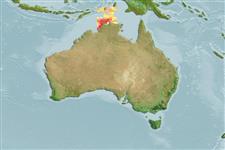>
Clupeiformes (Herrings) >
Engraulidae (Anchovies) > Engraulinae
Etymology: Stolephorus: Greek, stole, -es = garment + Greek, pherein = to carry (Ref. 45335).
Environment: milieu / climate zone / depth range / distribution range
Ökologie
seewasser; tiefenbereich 0 - 50 m (Ref. 189). Tropical; 7°S - 14°S, 128°E - 135°E (Ref. 189)
Western Central Pacific: known from a single specimen from Saulte Point, Coburg Peninsula, Northern Territory, Australia.
Size / Gewicht / Alter
Maturity: Lm ? range ? - ? cm
Max length : 7.2 cm SL Männchen/unbestimmt; (Ref. 189)
Rückenflossenstacheln (insgesamt) : 0; Afterflossenstacheln: 0; Afterflossenweichstrahlen: 16. With 7 small needle-like pre-pelvic scutes. Maxilla tip pointed, reaching only just to front border of pre-operculum; hind border of pre-operculum convex, rounded. Isthmus muscle tapering evenly forward to hind border of branchial membrane. Pelvic fin tips presumably not reaching to below dorsal fin origin. No dark pigment lines on back between head and dorsal fin.
Presumably coastal, pelagic and schooling, but more material and data needed. Egg presumed to be oval with a knob (as in S. indicus).
Life cycle and mating behavior
Geschlechtsreife | Fortpflanzung | Ablaichen | Eier | Fecundity | Larven
Whitehead, P.J.P., G.J. Nelson and T. Wongratana, 1988. FAO Species Catalogue. Vol. 7. Clupeoid fishes of the world (Suborder Clupeoidei). An annotated and illustrated catalogue of the herrings, sardines, pilchards, sprats, shads, anchovies and wolf-herrings. FAO Fish. Synop. 125(7/2):305-579. Rome: FAO. (Ref. 189)
IUCN Rote Liste Status (Ref. 130435: Version 2024-2)
Bedrohung für Menschen
Harmless
Nutzung durch Menschen
Fischereien: kommerziell
Tools
Zusatzinformationen
Download XML
Internet Quellen
Estimates based on models
Preferred temperature (Ref.
123201): 28 - 28.8, mean 28.3 °C (based on 46 cells).
Phylogenetic diversity index (Ref.
82804): PD
50 = 0.5000 [Uniqueness, from 0.5 = low to 2.0 = high].
Bayesian length-weight: a=0.00501 (0.00220 - 0.01140), b=3.14 (2.96 - 3.32), in cm total length, based on LWR estimates for this Genus-body shape (Ref.
93245).
Trophic level (Ref.
69278): 3.3 ±0.4 se; based on size and trophs of closest relatives
Widerstandsfähigkeit (Ref.
120179): hoch, Verdopplung der Population dauert weniger als 15 Monate. (Preliminary K or Fecundity.).
Fishing Vulnerability (Ref.
59153): Low vulnerability (10 of 100).
